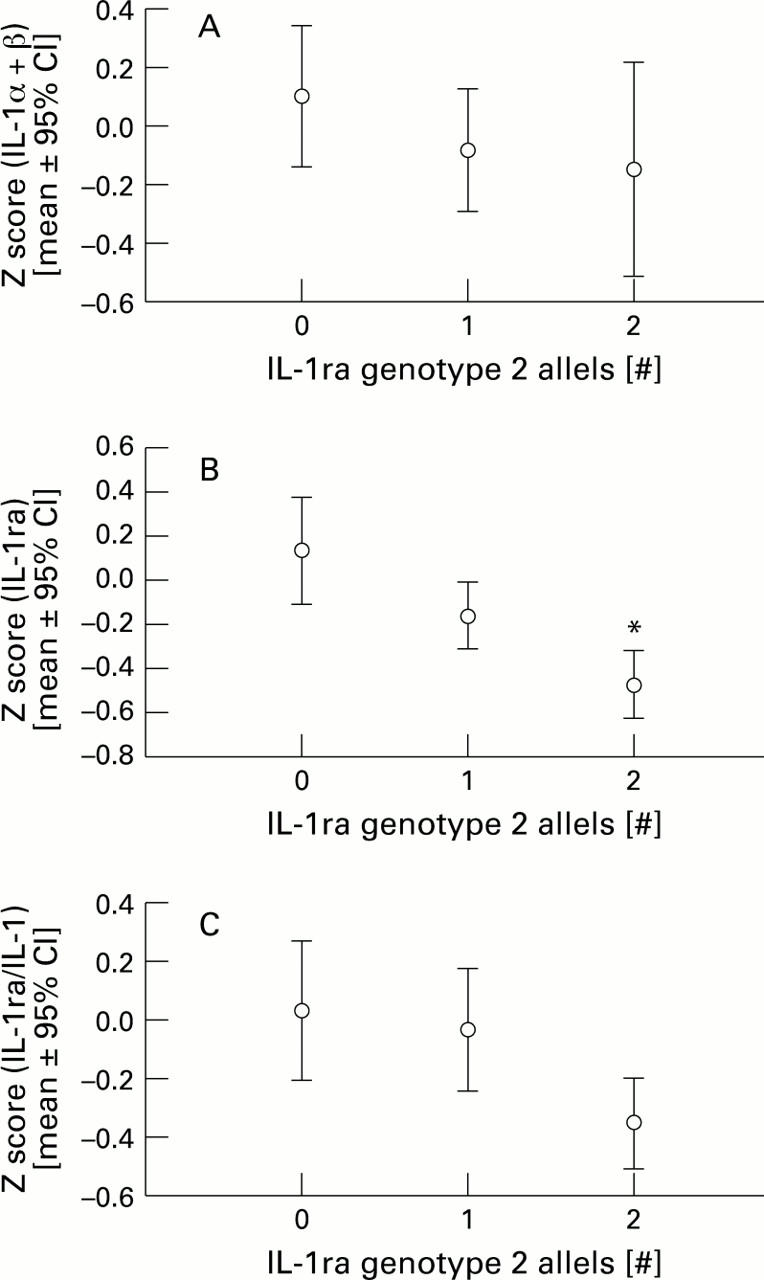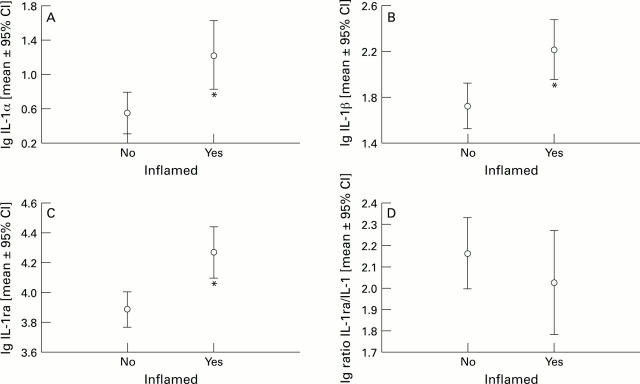Abstract
Background—Interleukin 1 (IL-1) α and β are potent cytokines which play key roles in inflammation. They are controlled by IL-1 receptor antagonist (IL-1ra). Aims—To investigate the influence of mucosal inflammation and IL-1ra genotype on the IL-1ra:IL-1 balance. Patients and methods—IL-1α, IL-1β, and IL-1ra were measured by enzyme linked immunosorbent assay (ELISA) in biopsy specimens taken from inflamed and non-inflamed colon of 60 patients with Crohn's disease (CD), 34 with ulcerative colitis (UC), 15 inflammatory controls, and 103 non-inflamed controls. IL-1ra genotype was determined by polymerase chain reaction and gel electrophoresis. Results—IL-1α and IL-1β were significantly increased in inflamed mucosa in inflammatory bowel disease (IBD) (CD: 53.5 (22.4) and 409.9 (118.7) pg/mg protein, respectively; UC: 18.9 (6.8) and 214.5 (78.2) pg/mg, respectively) and non-IBD patients (19.2(7.4) and 281.4 (121.0) pg/mg, respectively; p<0.0001) compared with normal controls (2.8 (0.6) and 30.6 (5.6) pg/mg, respectively). In CD IL-1α and β were also significantly increased in non-inflamed mucosa (6.1 (1.3) pg/mg and 88.7 (17.4) pg/mg, respectively; p<0.0012). IL-1ra:(IL-1α+β) ratios were significantly decreased in inflamed mucosa of patients with CD (182 (45); p<0.0001), UC (425 (136); p=0.0018) and without IBD (221 (76); p<0.0001), and in non-inflamed mucosa in CD (369 (149); p<0.0001) compared with normal controls (1307 (245); p<0.0001). Patients with IL-1ra genotype 2 had slightly but significantly reduced mucosal IL-1ra concentrations (p=0.003). The greatest difference was seen in colonic biopsy specimens from patients with inflamed Crohn's disease. Conclusion—Mucosal inflammation can modulate the balance of the IL-1:IL-1ra system in colonic mucosa.
Keywords: interleukin 1; interleukin 1 receptor antagonist; inflammatory bowel disease; Crohn's disease; mucosal inflammation; genotype
Full Text
The Full Text of this article is available as a PDF (167.6 KB).
Figure 1 .
: Different IL-1ra genotypes. The following genotypes are shown (from left to right) 1/3, 2/2, 1/1, 1/2, 1/2. A λ Pst l digest was used as size standard.
Figure 2 .
: IL-1α (A), IL-1β (B), IL-1ra (C), and IL-1ra:IL-1α+β ratios (D) in colonic mucosa. Data were logarithmically transformed (to achieve a normal distribution) and were expressed as means (95% confidence intervals). Asterisks indicate statistically significant differences compared with non-inflamed controls.
Figure 3 .
: Intraindividual concentrations of IL-1α (A), IL-1β (B), IL-1ra (C), and IL-1ra:IL-1α+β ratios (D) in inflamed and non-inflamed colonic mucosa of patients with CD. Data were logarithmically transformed (to achieve a normal distribution) and were expressed as means (95% confidence intervals). Asterisks indicate statistically significant differences between inflamed and non-inflamed regions.
Figure 4 .
: IL-1ra in colonic mucosa and genetic polymorphism of IL-1ra. Data were logarithmically transformed (to obtain a normal distribution) and are expressed as mean (SEM).
Figure 5 .

: Genetic polymorphism of IL-1ra and mucosal concentrations of IL-1α, IL-1β, and IL-1ra. IL-1(α+β) (A), and IL-1ra (B) were determined and ratios of IL-1ra:IL-1α+β were calculated (C). In order to combine the data of different groups the influence of diagnosis and inflammation was excluded by Z normalisation. The Z normalised values of the data are given as mean (95% confidence interval) and grouped by the number of IL-1ra genotype 2 alleles. The asterisk indicates a statistically significant difference compared with the patients with no IL-1ra allele.
Selected References
These references are in PubMed. This may not be the complete list of references from this article.
- Andus T., Targan S. R., Deem R., Toyoda H. Measurement of tumor necrosis factor alpha mRNA in small numbers of cells by quantitative polymerase chain reaction. Reg Immunol. 1993 Jan-Feb;5(1):11–17. [PubMed] [Google Scholar]
- Arend W. P. Interleukin-1 receptor antagonist. Adv Immunol. 1993;54:167–227. doi: 10.1016/s0065-2776(08)60535-0. [DOI] [PubMed] [Google Scholar]
- Bauditz J., Rückert Y., Raedler A., Nikolaus S., Lochs H., Schreiber S. Tumour necrosis factor inhibition by oxpentifylline and intestinal inflammation in Crohn's disease. Lancet. 1995 Jun 3;345(8962):1445–1445. doi: 10.1016/s0140-6736(95)92635-6. [DOI] [PubMed] [Google Scholar]
- Bioque G., Bouma G., Crusius J. B., Koutroubakis I., Kostense P. J., Meuwissen S. G., Peña A. S. Evidence of genetic heterogeneity in IBD: 1. The interleukin-1 receptor antagonist in the predisposition to suffer from ulcerative colitis. Eur J Gastroenterol Hepatol. 1996 Feb;8(2):105–110. [PubMed] [Google Scholar]
- Bioque G., Crusius J. B., Koutroubakis I., Bouma G., Kostense P. J., Meuwissen S. G., Peña A. S. Allelic polymorphism in IL-1 beta and IL-1 receptor antagonist (IL-1Ra) genes in inflammatory bowel disease. Clin Exp Immunol. 1995 Nov;102(2):379–383. doi: 10.1111/j.1365-2249.1995.tb03793.x. [DOI] [PMC free article] [PubMed] [Google Scholar]
- Blakemore A. I., Tarlow J. K., Cork M. J., Gordon C., Emery P., Duff G. W. Interleukin-1 receptor antagonist gene polymorphism as a disease severity factor in systemic lupus erythematosus. Arthritis Rheum. 1994 Sep;37(9):1380–1385. doi: 10.1002/art.1780370917. [DOI] [PubMed] [Google Scholar]
- Blakemore A. I., Watson P. F., Weetman A. P., Duff G. W. Association of Graves' disease with an allele of the interleukin-1 receptor antagonist gene. J Clin Endocrinol Metab. 1995 Jan;80(1):111–115. doi: 10.1210/jcem.80.1.7530255. [DOI] [PubMed] [Google Scholar]
- Brynskov J., Tvede N., Andersen C. B., Vilien M. Increased concentrations of interleukin 1 beta, interleukin-2, and soluble interleukin-2 receptors in endoscopical mucosal biopsy specimens with active inflammatory bowel disease. Gut. 1992 Jan;33(1):55–58. doi: 10.1136/gut.33.1.55. [DOI] [PMC free article] [PubMed] [Google Scholar]
- Cappello M., Keshav S., Prince C., Jewell D. P., Gordon S. Detection of mRNAs for macrophage products in inflammatory bowel disease by in situ hybridisation. Gut. 1992 Sep;33(9):1214–1219. doi: 10.1136/gut.33.9.1214. [DOI] [PMC free article] [PubMed] [Google Scholar]
- Casini-Raggi V., Kam L., Chong Y. J., Fiocchi C., Pizarro T. T., Cominelli F. Mucosal imbalance of IL-1 and IL-1 receptor antagonist in inflammatory bowel disease. A novel mechanism of chronic intestinal inflammation. J Immunol. 1995 Mar 1;154(5):2434–2440. [PubMed] [Google Scholar]
- Clay F. E., Cork M. J., Tarlow J. K., Blakemore A. I., Harrington C. I., Lewis F., Duff G. W. Interleukin 1 receptor antagonist gene polymorphism association with lichen sclerosus. Hum Genet. 1994 Oct;94(4):407–410. doi: 10.1007/BF00201602. [DOI] [PubMed] [Google Scholar]
- Cominelli F., Nast C. C., Clark B. D., Schindler R., Lierena R., Eysselein V. E., Thompson R. C., Dinarello C. A. Interleukin 1 (IL-1) gene expression, synthesis, and effect of specific IL-1 receptor blockade in rabbit immune complex colitis. J Clin Invest. 1990 Sep;86(3):972–980. doi: 10.1172/JCI114799. [DOI] [PMC free article] [PubMed] [Google Scholar]
- Cork M. J., Tarlow J. K., Clay F. E., Crane A., Blakemore A. I., McDonagh A. J., Messenger A. G., Duff G. W. An allele of the interleukin-1 receptor antagonist as a genetic severity factor in alopecia areata. J Invest Dermatol. 1995 May;104(5 Suppl):15S–16S. doi: 10.1038/jid.1995.37. [DOI] [PubMed] [Google Scholar]
- Crusius J. B., Peña A. S., Van Oosten B. W., Bioque G., Garcia A., Dijkstra C. D., Polman C. H. Interleukin-1 receptor antagonist gene polymorphism and multiple sclerosis. Lancet. 1995 Oct 7;346(8980):979–979. [PubMed] [Google Scholar]
- Daig R., Andus T., Aschenbrenner E., Falk W., Schölmerich J., Gross V. Increased interleukin 8 expression in the colon mucosa of patients with inflammatory bowel disease. Gut. 1996 Feb;38(2):216–222. doi: 10.1136/gut.38.2.216. [DOI] [PMC free article] [PubMed] [Google Scholar]
- Derkx B., Taminiau J., Radema S., Stronkhorst A., Wortel C., Tytgat G., van Deventer S. Tumour-necrosis-factor antibody treatment in Crohn's disease. Lancet. 1993 Jul 17;342(8864):173–174. doi: 10.1016/0140-6736(93)91375-v. [DOI] [PubMed] [Google Scholar]
- Dinarello C. A. Interleukin-1 and interleukin-1 antagonism. Blood. 1991 Apr 15;77(8):1627–1652. [PubMed] [Google Scholar]
- Dinarello C. A., Wolff S. M. The role of interleukin-1 in disease. N Engl J Med. 1993 Jan 14;328(2):106–113. doi: 10.1056/NEJM199301143280207. [DOI] [PubMed] [Google Scholar]
- Fiocchi C. Cytokines and animal models: a combined path to inflammatory bowel disease pathogenesis. Gastroenterology. 1993 Apr;104(4):1202–1205. doi: 10.1016/0016-5085(93)90294-m. [DOI] [PubMed] [Google Scholar]
- Gross V., Andus T., Caesar I., Roth M., Schölmerich J. Evidence for continuous stimulation of interleukin-6 production in Crohn's disease. Gastroenterology. 1992 Feb;102(2):514–519. doi: 10.1016/0016-5085(92)90098-j. [DOI] [PubMed] [Google Scholar]
- Hellers G., Bernell O. Genetic aspects of inflammatory bowel disease. Med Clin North Am. 1990 Jan;74(1):13–19. doi: 10.1016/s0025-7125(16)30582-x. [DOI] [PubMed] [Google Scholar]
- Hugot J. P., Laurent-Puig P., Gower-Rousseau C., Olson J. M., Lee J. C., Beaugerie L., Naom I., Dupas J. L., Van Gossum A., Orholm M. Mapping of a susceptibility locus for Crohn's disease on chromosome 16. Nature. 1996 Feb 29;379(6568):821–823. doi: 10.1038/379821a0. [DOI] [PubMed] [Google Scholar]
- Isaacs K. L., Sartor R. B., Haskill S. Cytokine messenger RNA profiles in inflammatory bowel disease mucosa detected by polymerase chain reaction amplification. Gastroenterology. 1992 Nov;103(5):1587–1595. doi: 10.1016/0016-5085(92)91182-4. [DOI] [PubMed] [Google Scholar]
- Kühn R., Löhler J., Rennick D., Rajewsky K., Müller W. Interleukin-10-deficient mice develop chronic enterocolitis. Cell. 1993 Oct 22;75(2):263–274. doi: 10.1016/0092-8674(93)80068-p. [DOI] [PubMed] [Google Scholar]
- Lennard A. C. Interleukin-1 receptor antagonist. Crit Rev Immunol. 1995;15(1):77–105. doi: 10.1615/critrevimmunol.v15.i1.30. [DOI] [PubMed] [Google Scholar]
- Ligumsky M., Simon P. L., Karmeli F., Rachmilewitz D. Role of interleukin 1 in inflammatory bowel disease--enhanced production during active disease. Gut. 1990 Jun;31(6):686–689. doi: 10.1136/gut.31.6.686. [DOI] [PMC free article] [PubMed] [Google Scholar]
- Louis E., Satsangi J., Roussomoustakaki M., Parkes M., Fanning G., Welsh K., Jewell D. Cytokine gene polymorphisms in inflammatory bowel disease. Gut. 1996 Nov;39(5):705–710. doi: 10.1136/gut.39.5.705. [DOI] [PMC free article] [PubMed] [Google Scholar]
- Mansfield J. C., Holden H., Tarlow J. K., Di Giovine F. S., McDowell T. L., Wilson A. G., Holdsworth C. D., Duff G. W. Novel genetic association between ulcerative colitis and the anti-inflammatory cytokine interleukin-1 receptor antagonist. Gastroenterology. 1994 Mar;106(3):637–642. doi: 10.1016/0016-5085(94)90696-3. [DOI] [PubMed] [Google Scholar]
- McCabe R. P., Secrist H., Botney M., Egan M., Peters M. G. Cytokine mRNA expression in intestine from normal and inflammatory bowel disease patients. Clin Immunol Immunopathol. 1993 Jan;66(1):52–58. doi: 10.1006/clin.1993.1007. [DOI] [PubMed] [Google Scholar]
- Mitoro A., Yoshikawa M., Yamamoto K., Mimura M., Yoshikawa Y., Shiroi A., Mochi T., Sakamoto T., Yamao J., Kikuchi E. Exacerbation of ulcerative colitis during alpha-interferon therapy for chronic hepatitis C. Intern Med. 1993 Apr;32(4):327–331. doi: 10.2169/internalmedicine.32.327. [DOI] [PubMed] [Google Scholar]
- Nicklin M. J., Weith A., Duff G. W. A physical map of the region encompassing the human interleukin-1 alpha, interleukin-1 beta, and interleukin-1 receptor antagonist genes. Genomics. 1994 Jan 15;19(2):382–384. doi: 10.1006/geno.1994.1076. [DOI] [PubMed] [Google Scholar]
- Nishiyama T., Mitsuyama K., Toyonaga A., Sasaki E., Tanikawa K. Colonic mucosal interleukin 1 receptor antagonist in inflammatory bowel disease. Digestion. 1994;55(6):368–373. doi: 10.1159/000201167. [DOI] [PubMed] [Google Scholar]
- Olson A. D., Ayass M., Chensue S. Tumor necrosis factor and IL-1 beta expression in pediatric patients with inflammatory bowel disease. J Pediatr Gastroenterol Nutr. 1993 Apr;16(3):241–246. doi: 10.1097/00005176-199304000-00003. [DOI] [PubMed] [Google Scholar]
- Orholm M., Iselius L., Sørensen T. I., Munkholm P., Langholz E., Binder V. Investigation of inheritance of chronic inflammatory bowel diseases by complex segregation analysis. BMJ. 1993 Jan 2;306(6869):20–24. doi: 10.1136/bmj.306.6869.20. [DOI] [PMC free article] [PubMed] [Google Scholar]
- Schreiber S., Heinig T., Thiele H. G., Raedler A. Immunoregulatory role of interleukin 10 in patients with inflammatory bowel disease. Gastroenterology. 1995 May;108(5):1434–1444. doi: 10.1016/0016-5085(95)90692-4. [DOI] [PubMed] [Google Scholar]
- Sparano J. A., Brandt L. J., Dutcher J. P., DuBois J. S., Atkins M. B. Symptomatic exacerbation of Crohn disease after treatment with high-dose interleukin-2. Ann Intern Med. 1993 Apr 15;118(8):617–618. doi: 10.7326/0003-4819-118-8-199304150-00007. [DOI] [PubMed] [Google Scholar]
- Steinkasserer A., Spurr N. K., Cox S., Jeggo P., Sim R. B. The human IL-1 receptor antagonist gene (IL1RN) maps to chromosome 2q14-q21, in the region of the IL-1 alpha and IL-1 beta loci. Genomics. 1992 Jul;13(3):654–657. doi: 10.1016/0888-7543(92)90137-h. [DOI] [PubMed] [Google Scholar]
- Stevens C., Walz G., Singaram C., Lipman M. L., Zanker B., Muggia A., Antonioli D., Peppercorn M. A., Strom T. B. Tumor necrosis factor-alpha, interleukin-1 beta, and interleukin-6 expression in inflammatory bowel disease. Dig Dis Sci. 1992 Jun;37(6):818–826. doi: 10.1007/BF01300378. [DOI] [PubMed] [Google Scholar]
- Whelan G. Epidemiology of inflammatory bowel disease. Med Clin North Am. 1990 Jan;74(1):1–12. doi: 10.1016/s0025-7125(16)30581-8. [DOI] [PubMed] [Google Scholar]
- van Dullemen H. M., van Deventer S. J., Hommes D. W., Bijl H. A., Jansen J., Tytgat G. N., Woody J. Treatment of Crohn's disease with anti-tumor necrosis factor chimeric monoclonal antibody (cA2). Gastroenterology. 1995 Jul;109(1):129–135. doi: 10.1016/0016-5085(95)90277-5. [DOI] [PubMed] [Google Scholar]






